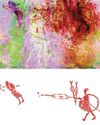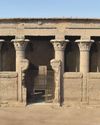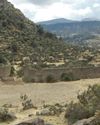
IN ANCIENT MESOPOTAMIA, irrigation was the key to civilization. Rivers such as the Tigris and Euphrates carried a plentiful flow of water, fed by snowmelt from the mountains of Anatolia to the north. However, unlike the Nile in Egypt, which flooded on a regular annual schedule that perfectly accommodated the growing seasons, Mesopotamian rivers did so unpredictably and violently. To protect against the havoc caused by untamed flooding and to provide a steady supply of water to cultivate the land, Mesopotamian kings saw the construction of irrigation systems as among their chief responsibilities.
The pride rulers took in these engineering feats is made clear by a number of celebratory rock reliefs that have been discovered near irrigation projects dating to the Neo-Assyrian Empire (883–609 b.c.). At the site of Khinis, for example, where the Gomel River emerges from a narrow gorge at the foot of the Zagros Mountains, the king Sennacherib (r. 704–681 b.c.) built a dam that diverted its waters into a canal that fed into a series of waterways snaking some 60 miles in all across the plains to the walls of his new capital at Nineveh. This canal was the crown jewel in an extensive regional irrigation network the king built. To commemorate his exploits, Sennacherib commissioned monumental reliefs, along with a lengthy cuneiform inscription, carved into a cliff rising above the canal head at Khinis. In the inscription, he claims that when he founded his new capital, its unwatered fields were “woven over with spider webs” and its people “did not know artificial irrigation, but had their eyes turned for rain (and) showers from the sky.” Thanks to his new canal network, Sennacherib writes, opulent gardens bloomed at Nineveh, and the countryside grew abundant with crops.
This story is from the May/June 2020 edition of Archaeology.
Start your 7-day Magzter GOLD free trial to access thousands of curated premium stories, and 8,500+ magazines and newspapers.
Already a subscriber ? Sign In
This story is from the May/June 2020 edition of Archaeology.
Start your 7-day Magzter GOLD free trial to access thousands of curated premium stories, and 8,500+ magazines and newspapers.
Already a subscriber? Sign In

A Very Close Encounter
New research has shown that human figures painted in red on a rock art panel in central Montana depict individuals engaged in a life-or-death encounter during an especially fraught historical moment.

A Sword for the Ages
A zigzag pattern, now tinged with the green-blue patina of oxidized metal, adorns the octagonal hilt of a rare sword dating to the Middle Bronze Age in Germany (1600-1200 B.C.) that was recently excavated in the Bavarian town of Nördlingen.

Ancient Egyptian Astrology
For centuries, layers of soot have coated the ceilings and columns in the entrance hall of Egypt's Temple of Esna. Now, an Egyptian-German team of researchers, led by Hisham El-Leithy of the Egyptian Ministry of Tourism and Antiquities and Christian Leitz of the University of Tübingen, is restoring the temple's vibrant painted reliefs to their original brilliance.

BRONZE AGE POWER PLAYERS
How Hittite kings forged diplomatic ties with a shadowy Greek city-state

RITES OF REBELLION
Archaeologists unearth evidence of a 500-year-old resistance movement high in the Andes

Secrets of Egypt's Golden Boy
CT scans offer researchers a virtual look deep inside a mummy's coffin

When Lions Were King
Across the ancient world, people adopted the big cats as sacred symbols of power and protection

UKRAINE'S LOST CAPITAL
In 1708, Peter the Great destroyed Baturyn, a bastion of Cossack independence and culture

LAPAKAHI VILLAGE, HAWAII
Standing beside a cove on the northwest coast of the island of Hawaii, the fishing village of Lapakahi, which is surrounded by black lava stone walls, was once home to generations of fishers and farmers known throughout the archipelago for their mastery of la'au lapa'au, or the practice of traditional Hawaiian medicine. \"

A MORE COMFORTABLE RIDE
Although the date is much debated, most scholars believe people 5,000 years ago. For thousands of years after that, they did so without saddles. \"In comparison with horse riding, the development of saddles began relatively late, when riders began to care more about comfort and safety in addition to the horse's health,\" says University of Zurich archaeologist Patrick Wertmann.